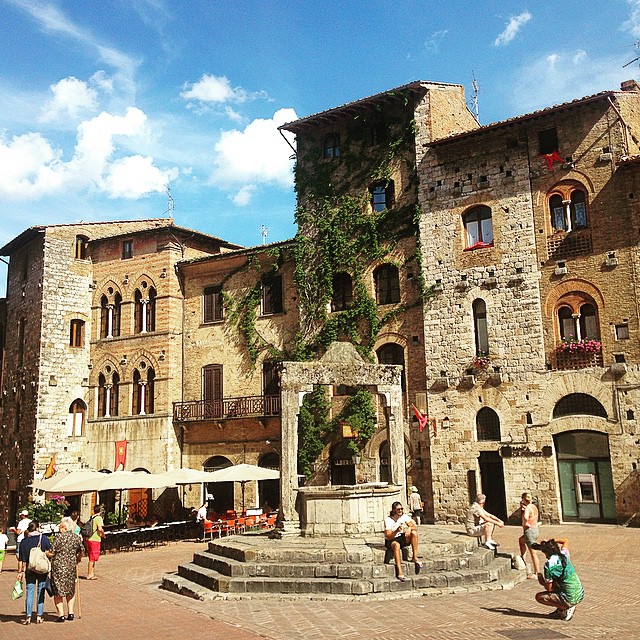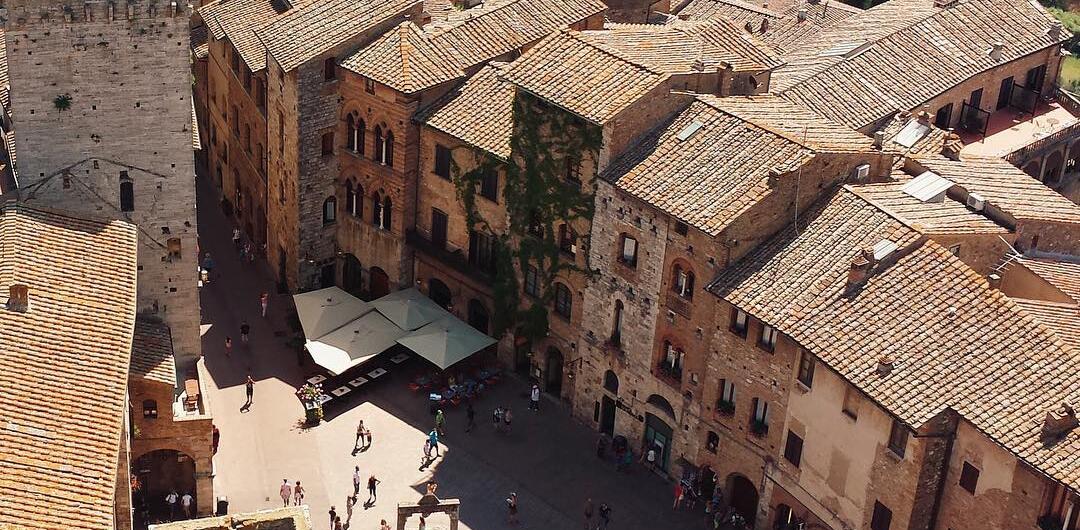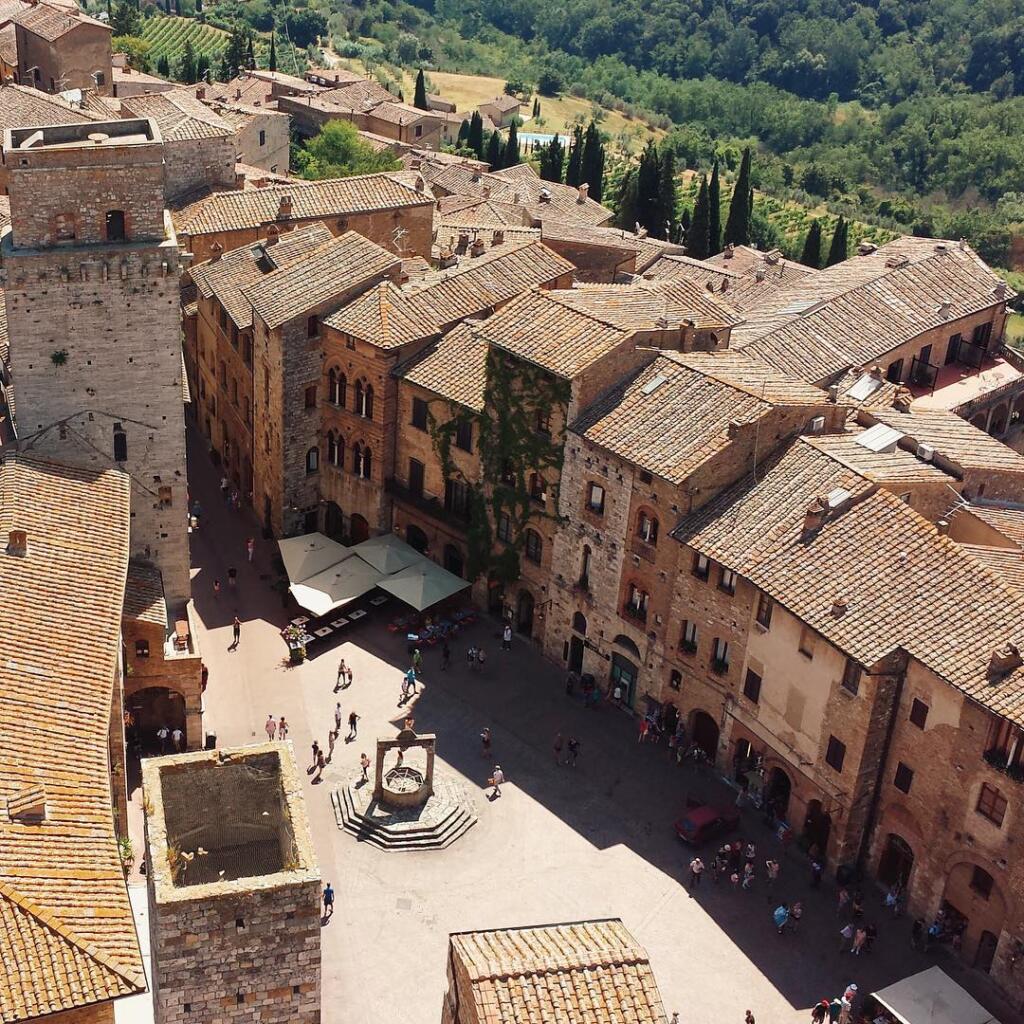San Gimignano: the “Medieval Manhattan” near Siena
Introduction
Immersed in the suggestive Tuscan countryside, between Siena and the Val d’Elsa, San Gimignano is a fortified medieval village declared a UNESCO World Heritage Site in 1990, perfect to visit in one day. The origins of this beautiful village in Tuscany dating back to the Etruscan era and then took shape during the Middle Ages, becoming a point of trade along with the well-known Via Francigena.
Destination throughout the year for tourists from all over the world, it is known for the presence of numerous towers, once a symbol of power and prestige, and for the atmosphere of other times that can be felt in every corner.
Read on and find out more about this enchanting village!
San Gimignano : what to see
Torre Rognosa
San Gimignano is nicknamed the “Manhattan of the Middle Ages” because of its towers, tall as skyscrapers, owned at the time of the 1300s by the wealthiest and most powerful families in the area. It was in fact right through the height of the towers that their wealth and family prestige were displayed.
In the past there were 72 of them, today there are 13 left, including the imposing Torre Rognosa, also called “Torre del Podestà” at the time used as a prison. Torre Rognosa, located in Piazza Duomo, is the oldest and best-preserved tower in San Gimignano, as well as being one of the tallest.
In 1255, in fact, a regulation prohibited all private individuals from erecting taller towers than the Torre Rognosa. In response to the act, two of the most powerful families of San Gimignano, the Salvucci family and the Ardinghelli family, had two twin towers of equal height but slightly lower than the Torre Rognosa built respectively, as proof of their family prestige.
Palace of the Podestà
Torre Rognosa literally dominates the Palazzo del Podestà built in 1249 and consisting of a large facade in local stone and terracotta. The entrance to the Palace is possible through a large vault, called La Loggia, where you can admire a fresco of Sodom from 1513 representing the Madonna and Child with Saints Geminiano and Nicola.

Torre Grossa
To make the profile of San Gimignano unmistakable, however, is also Torre Grossa, also located in Piazza Duomo, which stands out for being the tallest tower in the entire Tuscan village.
To access it and enjoy a breathtaking view of the Tuscan countryside, you must enter the Palazzo del Popolo, also called Palazzo Nuovo del Podestà, which, in addition to being an access point for the Tower, is one of the most interesting buildings of all San Gimignano.
The Palazzo del Popolo, now the seat of the Municipality of San Gimignano, contains the “historical” seat of the city’s Civic Museums, including the Dante Room decorated with cycles of chivalric-themed frescoes, a picture gallery with works from the 12th – XVII century and a frescoed courtyard with the coats of arms of the podestà.

Piazza Duomo
To start the visit of the town and immediately enjoy the view of these immense towers, start from one of its main squares, namely Piazza Duomo, the administrative and religious center of the town. Here stands the Cathedral of Santa Maria Assunta dating from the twelfth century.
The architecture of the Collegiate Church reflects multiple styles (Romanesque-Gothic, fifteenth-century and neoclassical), due to the numerous restorations and extensions undergone over time, which reflect the changes in the town.
Also worth seeing is its interior dotted with frescoes representing, among others, Stories of the New Testament, attributed to the School of Simone Martini, and Stories of the Old Testament by Bartolo di Fredi.
At the end of the east nave, you can admire the chapel of Santa Fina, a Renaissance masterpiece by Benedetto and Giuliano da Maiano.

Piazza della Cisterna (Cisterna Square)
If Piazza Duomo was once the political-religious centre of San Gimignano, the nearby Piazza della Cisterna stood out for being the place dedicated to citizens. Here, in fact, shops and taverns stood and markets, shows, parties and tournaments were usually organized.
Piazza della Cisterna is undoubtedly the emblem of San Gimignano, a witness of an era that is long gone but still alive and present, capable of transporting visitors back in time.
This is reflected in the ancient and suggestive cistern in the center of the square which once ensured the water supply of the Tuscan village and surrounding areas.
This octagonal travertine well, built-in 1273, forms the centrepiece of the square, in turn framed by towers and elegant buildings, among which the Palazzo Tortoli, the Albergo della Cisterna, Palazzo Razzi, Palazzo Ardinghelli with its two twin towers stand out.

Torre Lupi
Also relevant is the Torre Lupi, also called the Torre del Diavolo by virtue of the fact that its owner, returning from a long journey, found the tower inexplicably higher, thus blaming the devil for it.
In Piazza della Cisterna do not miss a tasty stop at the Gelateria del Dondoli, famous for its delicious homemade ice cream.
After Piazza della Cisterna it’s time to get lost in the maze of the suggestive streets that run throughout San Gimignano within its walls.
Do not miss the narrow Vicolo dell’Oro, once the home of goldsmiths and artisans, and continue on Via San Giovanni, one of the most important streets in the historic center.
If you are on the hunt for a souvenir of your trip out of town you will surely find it here. There are many shops that sell pottery, magnets, typical products and souvenir T-shirts.
Continue to the majestic Porta San Giovanni, the most important gate of San Gimignano built in 1262 and characterized by a lowered Sienese arch.
At this point, you can take an unusual and wonderfully suggestive route along the walls that enclose San Gimignano.
Thanks to this route it is possible to admire the panorama of the Valdelsa, meeting the Medici “Torrioni” and the main access doors to the town, all immersed in the green of the cypresses.
The journey time is approximately two and a half hours and during the walk, once you arrive at the Porta delle Fonti, you will be able to visit the public sources dating back to the XII century, where once the clothes were washed there.
A little further on, at the height of Porta San Matteo, inside the village, you will meet another square worthy of note: Piazza Sant’Agostino.
Rocca of Montestaffoli
To conclude your trip, you cannot miss a visit to one of the most panoramic points of San Gimignano: the Rocca di Montestaffoli. Built on a hillock, it dominates the whole of San Gimignano and the surrounding countryside, giving you breathtaking views.
The Rocca, restored in the 1900s, was once a pentagonal open-air defensive fortress, completely lapped by a circle of walls, and framed by turrets at every corner.
Today you can climb the only remaining tower for free and thus enjoy the view.
The Rocca di Montestaffoli is today a place of fun and entertainment where concerts and theatrical performances are organized during the summer season.
Its interior is enriched by olive trees and green spaces where it is not difficult to see street artists who give melodious music to passersby or who exhibit their works.
The atmosphere is truly magical!

Enogastronomy and Typical Products
San Gimignano is known not only for its historical and urban heritage, but also for its food and wine products. The vineyards of olive and Vernaccia, the latter speciality of the Tuscan village known all over the world, extend immense on the hills of the Valdelsa.
But not only: try also the cured meats, such as the Tuscan PDO Prosciutto with its intense and unmistakable flavor, the Tuscan salami and the superscript.
The cheeses are also excellent, such as fresh, semi-seasoned and seasoned Pecorino and Marzolino available only a few months a year.
San Gimignano also stands out for the production of honey from that of acacia, sunflower, chestnut and wildflower.
For a tasting of these typical and genuine products, we recommend the Enoteca La Vecchia Nicchia **, in Via San Martino. A cozy place where to taste, in addition to the meats and cheeses of the area, the famous Tuscan bruschetta and an excellent Ribollita.
Related links:
• 10 Typical Tuscan Dishes You Must Try
When to go to San Gimignano
Thanks to an always favorable weather, San Gimignano can be visited at any time of the year.
We recommend spring and autumn to enjoy the beautiful colors of the surrounding countryside.
Even the winter, albeit from the harshest climate, is an excellent period as the patron saint of the city is celebrated on 31 January, while during the month of February you can attend the Carnival celebrations, with folkloristic parades of allegorical floats accompanied by music and many confetti.
Not to be missed, every third weekend of June, the “Festa delle Messi”: a historical event where storytellers and actors are organized, stalls of the time and medieval arts and crafts are set up.
While between July and August do not miss the “San Gimignano d’Estate” with shows and concerts of symphonic and chamber music.
Being known all over the world, San Gimignano attracts many tourists; we recommend, if you can, to visit it during a weekday in order to explore it in peace.
The Surroundings and not only
Montespertoli
Thanks to its strategic position San Gimignano is ideal as a starting point to explore the whole region and its towns. Not only the most famous cities, such as Florence and Siena, but also Montespertoli, just 30 kilometres away, nestled between the Valdelsa and the Val di Pesa.
In a postcard setting, Montespertoli is immersed in the beauty of the rolling Tuscan hills and offers its visitors fairytale scenarios.
The town is known to most for the presence of prestigious villas and castles, two above all the Castle of Montegufoni of the Acciaioli family and the Castle of Sonnino which belonged to the Machiavelli family for centuries.
Discover this town through the tastings of its food and wine products, such as truffles and wine.
Just at the end of May, the city hosts the “Mostra del Chianti” a unique opportunity dedicated to food and wine tasting.
Sinalunga
Another village worth a visit is Sinalunga, in the province of Siena.
The historic center is distinguished by the Palazzo Pretorio and its bell tower, the Church of Santa Maria delle Nevi and the Church of the Holy Cross.
But not only that, Sinalunga is known for being an excellent starting point for outdoor excursions, perhaps by bicycle.

Ansedonia
If instead, you are a seaside town full of history, what you are looking for, Ansedonia at the foot of Monte Argentario, in the province of Grosseto, is definitely for you.
Ansedonia is in fact known to most for the National Archaeological Museum of Cosa, a Roman colony located on the hill, for the towers of San Pancrazio and San Biagio, but also for the two splendid beaches with crystal clear sea: one facing the Argentario, the another towards Capalbio.+







Comments